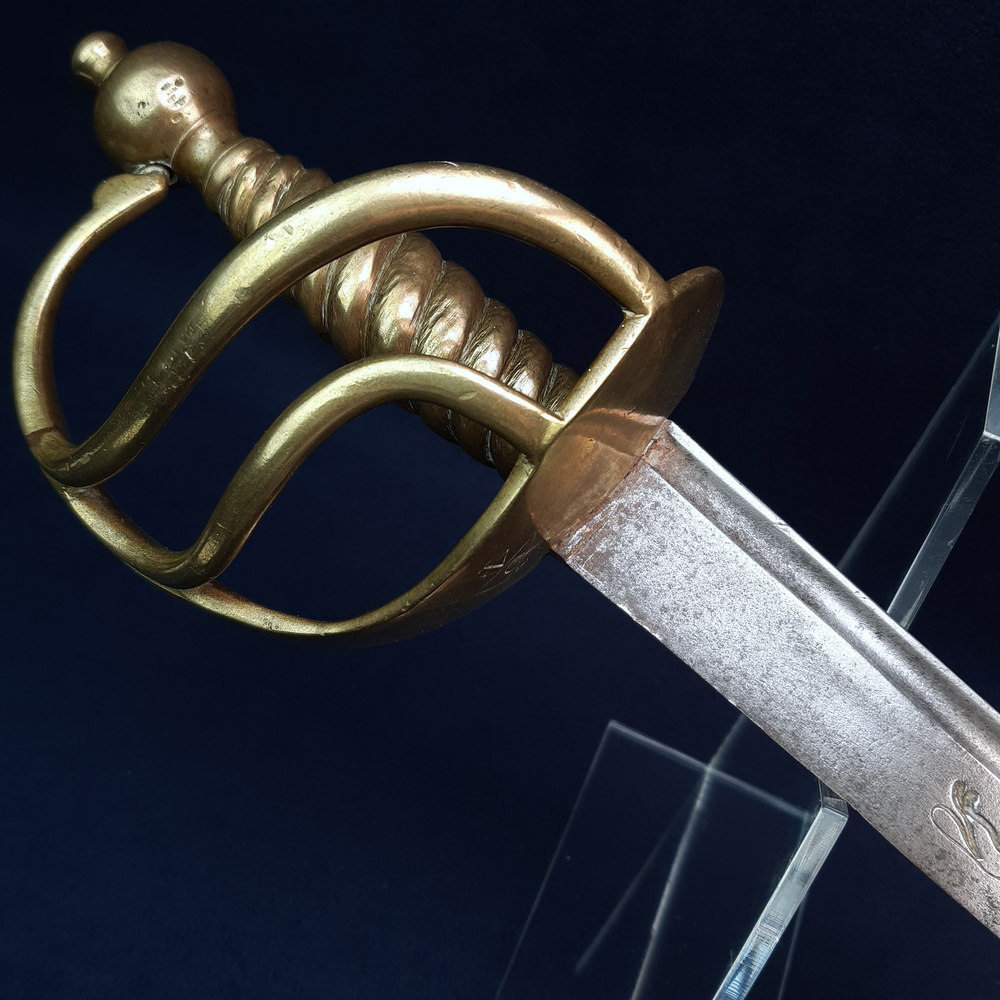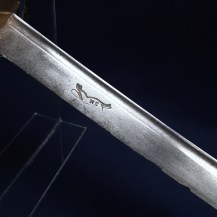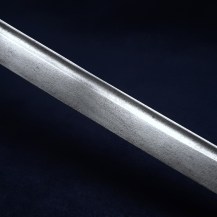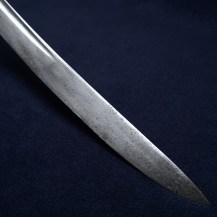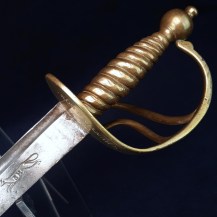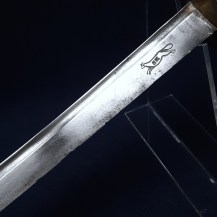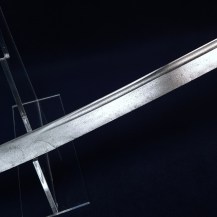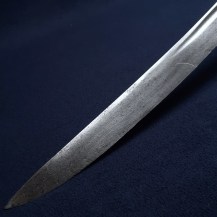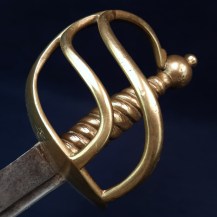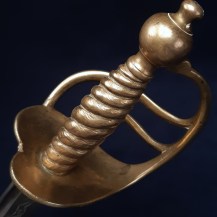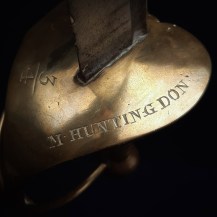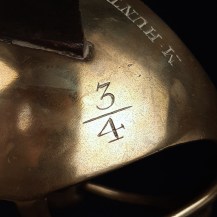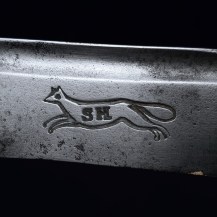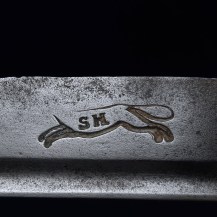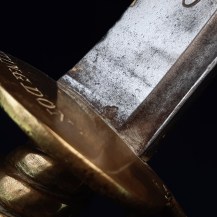English 1751 Pattern Infantry Hanger, Huntingdonshire Militia, by Samuel Harvey
Slightly curved hanger blade with hatchet point, single narrow fuller close to the spine. Cast brass heart-shaped hilt with two side bars, spiral grip and round pommel. No scabbard. Blade 24 7/8 inches (63.2cm) in length, the sword 30½ inches (77.5cm) overall.
The outside of the hilt is engraved with ‘M. HUNTINGDON’ indicating issue to the Huntingdonshire Militia and ‘3 / 4’, most likely a rack number. The blade is stamped on both sides with a running fox within which are the initials ‘SH’, indicating the maker Samuel Harvey. It is also stamped at the shoulder on one side with a crown mark. This indicates government inspection or ownership and suggests this hanger was part of an officially ordered production run.
The ‘1751 Pattern’ is not an official pattern of British sword (built to specifications set by the military establishment) but a widely used type that appeared around that date, was purchased officially to some degree and issued to many regiments. In this era colonels of regiments typically controlled procurement of equipment but market availability affected their choices and some larger-scale ordering took place. The 1751 is simple and durable, its blade typical of the British ‘hanger’, and survives in some numbers today considering its age. Almost all examples are marked to a militia unit.
The Huntingdonshire Militia was one of many created by the Militia Act of 1757 to respond to the threat posed by France during the Seven Years War. Parish constables drew up lists of all men aged 18 – 50, with limited exemptions, then drew ballots to select some for three years of compulsory militia service, although men chosen could delegate their role to paid substitutes if they could find & afford them.
Militia units were for home defence only, and could not be sent overseas – service in practice meant a few weeks of training each year and occasional mustering for duty in keeping public order, almost always outside their home county. Nonetheless, the compulsory system was unpopular and riots broke out in Lincolnshire in 1757 over the Bill’s passage, some wrongly believing that it meant they would be conscripted into fighting overseas. Several counties delayed implementing the changes for years for fear of similar civil unrest.
Uniform and equipment was provided for militiamen by the government - along with their muskets and bayonets the rank and file were armed with ‘Small Hangers, with Brass Hilts, Scabbards, and tanned Leather Waist-Belts’.
The regiment’s periods of embodiment are not recorded. In 1852 it became the 2nd, or Huntingdonshire Rifle Regiment of Militia. In 1881 the Childers Reforms amalgamated militia and volunteer units with the regulars into larger regiments, attaching the county militia units to their respective county’s regiments as their third or fourth battalions. The Huntingdonshire regiment was an unusual case in that it became the 5th (Huntingdonshire Militia) Battalion of the King’s Royal Rifle Corps, a regiment which had no county associations.
This may have occurred because the same reforms amalgamated Huntingdonshire’s county regiment, the 31st (Huntingdonshire) Regiment of Foot, with the 70th (Surrey) to form the new East Surrey Regiment, so there was no longer a true Huntingdonshire regiment for the militia to join with. The new battalions of the KRRC (more than most regiments received, reflecting the larger size of the KRRC which had four regular battalions) were a geographic hodgepodge: Huntingdonshire and Middlesex in England, Flintshire in Wales, Cork and Carlow in Ireland - but this to some degree reflected the national scope of the Rifles’ recruitment.
In 1908 the Haldane reforms converted Militia into ‘Special Reserve’ units, and the battalion became the 5th (Reserve) Battalion, The King’s Royal Rifle Corps. The KRRC’s militia affiliations outside the county of Middlesex appear to have ceased at this time, reflecting a drive to anchor regiments more firmly in geographic areas, so the 5th battalion was no longer particularly associated with Huntingdonshire. It was primarily a training unit during WW1 supplying trained men to the regular battalions, but being temporarily based at Sheerness on the Isle of Sheppey it was also part of the garrison protecting the Royal Naval Dockyard there and the coastal defences that guarded the mouth of the Thames.
The 5th Battalion was disbanded in 1953, ending the lineage of the Huntingdonshire Militia. The KRRC amalgamated with other units to form the Royal Green Jackets and its lineage is maintained today by 2nd Battalion, The Rifles.
The firm of Samuel Harvey was established in 1748, and used the mark of the ‘running fox’ on both sides of their sword blades. After Samuel’s death in 1778 the family business was continued by his son and grandson, both of the same name, the last of whom died in 1810.
Like other swords of this period the hanger has a low carbon tang and shoulder, forge welded to a higher carbon steel blade, and the differential aging of the two materials can be seen clearly at the transition point, about 2½ inches from the shoulder.
The hanger is solid in the hand with no movement to the hilt. The blade has some very light speckled pitting overall with some patches of moderate pitting near the edge at the forte of the blade and around the tip on both sides. A few forging marks. The sharp edge has a few small nicks towards the tip and some larger nicks and chips at the forte. The brass parts have a light, even patina with a few spots of darker patina on the inside of the guard. The short quillon has been lost. No cracks to the hilt bars, though the inner bar has been pushed slightly inwards. The short quillon usually found on this type has been lost.

